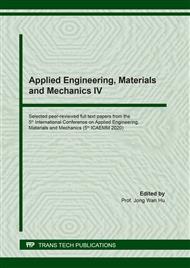[1]
L. Bertolini, B. Elsener, P. Pedeferri, E. Redaelli, R. B. Polder, Corrosion of Steel in Concrete: Prevention, Diagnosis, Repair, Bedin: Wiley-VCH, (2004).
DOI: 10.1002/9783527651696
Google Scholar
[2]
I. G. Rodionova, O. N. Baklanova, A. I. Zaitsev, On the role of nonmetallic inclusions in the acceleration of local corrosion of oil-field pipelines made of carbon and low-alloy steels, Russian metallurgy (Metally), 5 (2004) 414-418.
Google Scholar
[3]
I. I. Reformatskaya, A. N. Podobaev, I. G. Rodionova, Y. A. Bejlin, L. A. Nisel'son, I. R. Begishev, The role of microstructure of carbon and low alloy steels in process of their local corrosion, Corr. Mater. Protect. 3 (2005) 13-17.
Google Scholar
[4]
H. H. Strehblow, Nucleation and repassivation of corrosion pits for pitting on iron and nickel, Mater. Corr., 27(11) (1976) 792-799.
DOI: 10.1002/maco.19760271106
Google Scholar
[5]
G. S. Frankel, Pitting corrosion of metals a review of the critical factors, Journal of the Electrochem. Soc. 145(6) (1998) 2186-2198.
DOI: 10.1149/1.1838615
Google Scholar
[6]
H. H. Strehblow, Pitting corrosion, Encyclopedia of Electrochemistry, Online (2007).
Google Scholar
[7]
H. H. Strehblow, Mechanism of pitting corrosion, Corrosion Mechanisms in Theory and Practice, (1995) 201-238.
Google Scholar
[8]
W. P. Yang, D. Costa, P. Marcus, Oxide Films on Metals and Alloys, Electrochem. Soc. 92-22 (1922) 516.
Google Scholar
[9]
P. Marcus, J. M. Herbelin, The entry of chloride ions into passive films on nickel studied by spectroscopic (ESCA) and nuclear (36Cl radiotracer) methods, Corr. Sci. 34(7) (1993) 1123-1145.
DOI: 10.1016/0010-938x(93)90293-p
Google Scholar
[10]
C. L. McBee, J. Kruger, Localized Corrosion, RW Staehle et al, (1974) 252.
Google Scholar
[11]
W. Paatsch, Optische Untersuchungen zum Entstehungsmechanismus der Lochfraßkorrosion, Berichte der Bunsengesellschaft für physikalische Chemie, 77(10-11) (1973) 895-898.
DOI: 10.1002/bbpc.v77:10/11
Google Scholar
[12]
D. R. Latypova, O. R. Latypov, D. E. Bugai, Influence of electrode potential on the depth of pitting corrosion in the surface structures of placed steel, Nanotechnol. Constr. 10(3) (2018) 167-178.
DOI: 10.15828/2075-8545-2018-10-3-167-178
Google Scholar
[13]
M. A. Maleeva, M. A. Petrunin, L. B. Maksaeva, T. A. Yurasova, A. I. Marshakov, Local corrosion dissolution of steel in earth-simulating solutions, Protect. Metals Phys. Chem. Surf. 52(7) (2016) 1107-1113.
DOI: 10.1134/s2070205116070133
Google Scholar
[14]
T. V. Svistunova, A. P. Shlyamnev, Steels with improved resistance to local kinds of corrosion, Corr. Mater. Protect. 2 (2006) 2-8.
Google Scholar
[15]
M. Yasuda, T. Taga, Y. Ogata, T. Lida, F. Hine, Pitting corrosion behavior of stainless steels in NaCl solutions under heat transfer conditions, J. Soc. Mater. Sci. Jap. 35(396) (1986) 1049-1053.
DOI: 10.2472/jsms.35.1049
Google Scholar
[16]
C. Lin, L. Xiaogang, C. Dong, Pitting and galvanic corrosion behavior of stainless steel with weld in wet-dry environment containing Cl−, J. Uni. Sci. Technol Beijing, Mineral, Metallurgy, Material, 14(6) (2007) 517-522.
DOI: 10.1016/s1005-8850(07)60120-0
Google Scholar
[17]
V. Y. Rumyantseva, V. S. Konovalova, N. M. Vitalova, Corrosion inhibition of reinforced concrete structures, Constr. Reconstr. 4(54) (2014) 65-72.
Google Scholar
[18]
S. V. Fedosov, V. Y. Rumyantseva, K. Y. Rumyantseva, V. S. Konovalova, M. E. Shesterkin, Features of cold bonderizing of reinforcing steel, Bulle. Civ. Eng. 2(31) (2012) 79-82.
Google Scholar
[19]
V. E. Rumyantseva, V. S. Konovalova, I. N. Goglev, The effect of modified phosphate coatings on the corrosion resistance of steels, Materials of the International Conference, Scientific research of the SCO countries: synergy and integration, Rep. English Part 1, Beijing, PRC, 125-132.
Google Scholar
[20]
S. V. Fedosov, V. E. Roumyantseva, V. S. Konovalova, Phosphate coatings as a way to protect steel reinforcement from corrosion, MATEC Web of Conf. 298 (2019) 00126.
DOI: 10.1051/matecconf/201929800126
Google Scholar


